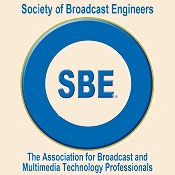Wednesday, April 21st Digital Wireless Microphone Theory by Sennheiser As TV spectrum condensed for a second time broadcasters struggle with available channel space for wireless microphones. The spectrum efficiency of digital microphone technology may be the answer going forward. Brian Walker, Business Development Manager, Professional Audio, for Sennheiser Electronic Corporation will speak to us about the latest Digital Wireless Microphone Theory. 7:00 PM - Meeting/Program This meeting is Virtual Connection information will be distributed in the days just prior to the meeting. Look Back 6 YearsVoting is now OpenIt's easy, just click on "Cast your Ballot on line" in the Elections box on the front page, then follow the prompts. You'll need your last name and your membership number (on your membership card) to get to the ballot. Thanks to all candidates and to Leonard Charles and Kevin Ruppert who are serving on this year's Nominations Committee. Voting will remain open until our April 21st Chapter meeting. Last Meeting's Minutes
|
|
There were no Wisconsin actions in March |
Certification and Education
compiled by Jim Hermanson
Congratulations to...
Vicki W. Kipp for passing the new ATSC 3.0 SBE Certification!
Dennis Baldridge for passing the new ATSC 3.0 SBE Certification!
SBE Chapter 24 Member ATSC 3.0 Exam Experience
Vicki and Dennis are likely among the very first in the world to take and pass this certification. We are very proud of them. I asked Vicki and Dennis to say a few words about this new exam experience.
Dennis Baldridge shared this... "Late last year, I was asked by the SBE certification committee to participate in the ATSC3 beta testing program. Not only did I have to take the test and answer the questions, but also provide input to any confusing questions, errors or omissions.
I must say it was the most difficult test I had ever taken from the SBE and found it very challenging or maybe I'm just getting old:) I half expected to fail but did however pass..."
Vicki W. Kipp shared this...
"For me, this exam was more challenging than other SBE exams. It was difficult.
Prepping for the SBE ATSC 3.0 Certification Exam
Dennis Baldridge and I both took the SBE's ATSC 3.0 specialist exam. It turns out that we used some of the same approaches to studying.
When you take the exam, there are 50 open-book multiple-choice questions. During the open book portion of the exam, you can use your written materials and use your computer to look things up online.
After you complete the multiple-choice questions, there is a closed-book essay question. The ATSC 3.0 specialist exam has one essay question about ATSC 3.0. This essay question is not customized for your job like the Engineering level certification essay questions are.
The is the first time I've taken an exam without studying the SBE's CertPreview first. The CertPreview for the ATSC 3.0 certification is still being developed. I made some flashcards on Quizlet.com, but it was no substitute for a SBE CertPreview.
I decided to study everything that SBE Certification Director Megan Clappe listed on the SBE's list of ATSC 3.0 suggested materials, and then some. This approach worked for me, but it might be overkill for some people. http://sbe.org/certification/suggested-references-materials-for-sbe-specialist-certifications-8-vsb-amd-drb/
The SBE's six ATSC 3.0 Modules and their three ATSC 3.0 Networking Modules are highly relevant. I have emails from Cathy Orosz with the registration links to all of the ATSC 3.0 sessions. Experts like Madeleine Noland, Luke Fay, Merrill Weiss, Dr. Youngkwon Lim, Dr. Kyungmo Park, and Charles Lo teach ATSC 3.0 modules 1-6. SBE President Wayne Pecena teaches the ATSC 3.0 Networking Modules 1-3.
Most of the SBE ATSC 3.0 webinars had PowerPoints available for download. I printed those PowerPoints and took notes on them while watching the webinars.
The SBE lists the NextGenTV Host Station Manual as a resource. I got a lot of use out of this manual. It's worth noting that Dave Folsom at Pearl releases updated versions of this book from time to time. I also watched Pearl's eight ATSC 3.0 webinars. The webinars progress in a different order than the manual, so I took standalone notes. https://pearltv.com/station-resources/
I also ran through the seven SBE@PBS TechCon 2019 webinars, which include real-life ATSC 3.0 applications from the 2018 Winter Olympics in Pyeongchang, South Korea. http://sbe.org/education/webinars-by-sbe/atsc3-tutorial-pbs-techcon-2019/
I skimmed through the ATSC 3.0 standards mentioned in the SBE's suggested resources list. https://www.atsc.org/atsc-documents/type/3-0-standards/
To hear ATSC 3.0 described from additional perspectives, I read the ATSC 3.0 Transition and Implementation Guide. It can be downloaded from Meintel, Sgrignoli, and Wallace's website. This guide has many expert contributors. https://mswdtv.com/atsc-3-0/
Ready to sign up for the exam? Head on over to http://sbe.org/certification/certification-levels/specialist-certifications/ "
Thank you, Vicki and Dennis. Congratulations on this achievement in your state-of-the-art education1!
The Open Exam Schedule
| Exam Dates | Location | Application Deadline (to SBE National Office) |
June 4-14, 2021 |
Local Chapters (Madison Area) |
April 16, 2021 |
August 6-16, 2021 |
Local Chapters (Madison Area) |
June 11, 2021 |
November 5-15, 2021 |
Local Chapters (Madison Area) |
September 10, 2021 |
Each year, account balance permitting, Chapter 24 will reimburse half the application fee to any member of Chapter 24 in good standing who successfully obtains any SBE certification level not previously held by that member. Contact the SBE Chapter 24 chairperson or certification chairperson for more information.
When you are ready to take an SBE exam, note the open exam schedule, complete the appropriate application (found here... http://www.sbe.org/applications) and send it directly to the SBE National office (see address below) with the respective fee. You will be notified once your application is approved. Your local certification chairman will receive a list of applicants and exams in his/her chapter and arrange for a proctor. He/she will then contact applicants to schedule a mutually agreeable date, time, and place for the exam(s) within the respective exam date window. This must be coordinated before the exam will be sent by SBE National. Completed exam(s) will be mailed back to SBE National for grading. Pass/fail results will be mailed directly to the applicants within approximately six weeks.
The majority of SBE certifications are open book and access to the Internet is allowed to give a more "real world" situation.
|
Megan E. Clappe Certification Director 9102 N. Meridian St. Suite 150 Indianapolis, IN 46260 317-846-9120 Fax mclappe@sbe.org |
To apply for a specialist certification, an individual must currently hold certification on the Broadcast Engineer, Senior Broadcast Engineer, Professional Broadcast Engineer or Broadcast Networking Engineer Certification level. Exams must be completed within three hours and consist of 50 multiple-choice questions (two points each) and one essay question (20 points maximum). Examinees are provided one essay question to answer. Exams are pass/fail, and a score of 84 is a passing grade.
SBE Rolls Out Training Program for New Broadcast/Media Engineers
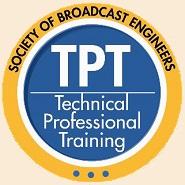 Utilizing a number of current SBE programs, the SBE is uniquely positioned to provide a valuable service to the broadcast industry: training new entrants to the field. The SBE is offering the SBE Technical Professional Training Program, an affordable and time sensitive way to train newer and entry level technical professionals at television and radio stations. The program includes:
Utilizing a number of current SBE programs, the SBE is uniquely positioned to provide a valuable service to the broadcast industry: training new entrants to the field. The SBE is offering the SBE Technical Professional Training Program, an affordable and time sensitive way to train newer and entry level technical professionals at television and radio stations. The program includes:
• The SBE Engineering Handbook, published by McGraw Hill and SBE, is a hard copy reference volume for hands-on use in designing and maintaining technical facilities.
• The SBE Mentor Program - providing new entrants (mentees) to our profession with regular access and guidance from a seasoned professional.
• The SBE Certification Program entry-level certification, Certified Broadcast Technologist (CBT) exam, demonstrating a comprehension of technical and regulatory requirements of station operation.
• The SBE CertPreview (exam preparation) for the CBT certification, along with the mentor's knowledge and experience, in support of the TPT participant to help prepare for the CBT exam.
For more information contact Education Director Cathy Orosz at the SBE National Office.
April Live Webinars
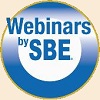
Cloud Streaming: Techniques for Executing Content for Maximum Distribution
April 22, 2021, 1 PM CT
Streaming your radio station or other audio content live to the Internet can bring hundreds, thousands, or hundreds of thousands of listeners to your programming. This short tutorial will give you the confidence to move ahead, understanding the basic process. We'll begin with audio processing, which is more important than you might imagine. Next we'll dive into audio encoding technologies including multi-rate streaming. We'll look into metadata insertion, too. Then we'll discuss the most common methods to gain appropriate streaming distribution to your audience. Finally, we'll see which of these functions can effectively be done in an Internet cloud environment.
Attendees will gain a good working understanding of the streaming audio process from playout to end listener.
About Your Instructor
Kirk A. Harnack, CBRE, CBNE
Senior Systems Consultant
The Telos Alliance
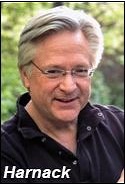
Kirk Harnack, CBRE, CBNE, brings 40 years of hands-on experience in broadcast engineering and education to his position as senior solutions consultant at the Telos Alliance. His expertise in putting technology to work in broadcast facilities has driven notable expansion in audio over IP, VoIP for broadcast, audio processing and other new technology adoption by content creators.
Kirk maintains an active, hands-on-role in broadcast engineering through his positions as a partner and VP engineering of South Seas Broadcasting, Inc., Delta Radio, LLC, and Kaua'i Broadcast Partners, totaling 14 AM and FM radio stations. He is a broadcast meteorologist (WSMV, Nashville), fixed-wing private pilot, FAA Part 107 SUAS pilot and licensed General Class Amateur Radio operator (KD5FYD). He is a member of the Board of Directors of the SBE and is program chair of SBE Chapter 103 in Nashville.
Kirk founded and hosts the Internet video netcast, This Week in Radio Tech (TWiRT). The one-hour weekly video netcast features regular contributors and guests from the world of radio engineering.
SBE Recertification Credit
The completion of a Webinar from Webinars by SBE qualifies for 1 credit, identified under Category I of the Recertification Schedule for SBE Certifications.
Registration and Pricing
SBE Members: $62
MemberPlus Members FREE
Non-Members: $92
SBE MemberPlus members: When registering, be sure to click on the MemberPlus link to activate your MemberPlus benefit to register for free. Not a SBE MemberPlus member? For more information, see below.
Register Here
Questions?
If you have questions regarding this course, contact Cathy Orosz via email or by phone at 317-846-9000.

2021 IP Networking, Part 4
April 29, 2021, 1 PM CT
The 2021 IP Networking series continues with Module 4: Network Architecture & Design for Real-Time Media on Thursday, April 29, 2021. Part 4 of the series will focus on understanding network architecture and network design for real-time media transport. Topics to be covered include: the LAN versus the WAN; layered network design; selecting network hardware; redundancy and high availability; network design considerations for performance; private & public IP addressing; the subnet and the supernet; network address translation; broadcast and media networks NTP & PTP; and an introduction to IPv6.
About Your Instructor
Wayne Pecena, CPBE, 8-VSB, AMD, ATSC3, DRB, CBNE
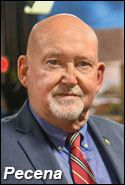
Wayne M. Pecena is the Associate Director of Educational Broadcast Services at Texas A&M University. Wayne has over 48 years of broadcast and IP network engineering experience and holds BS and MS degrees from Texas A&M University. Wayne is a Fellow of the Society of Broadcast Engineers (SBE) and holds the Certified Professional Broadcast Engineer (CPBE) and Certified Broadcast Network Engineer (CBNE) certifications from the SBE. He currently serves in his second term as the national President of the SBE. He was named the 2012 SBE Educator of the Year, the 2014 Radio World Engineer of the year, and named an IEEE-BTS Distinguished Lecturer in 2018. He is a frequent industry speaker on IP Networking and cybersecurity topics for the broadcast and media technology professional.
SBE Recertification Credit
The completion of a Webinar from Webinars by SBE qualifies for 1 credit, identified under Category I of the Recertification Schedule for SBE Certifications.
Registration and Pricing
This Webinar will be approximately 90 minutes long.
SBE Members: $62
MemberPlus Members FREE
Non-Members: $92
Registration Link
If you have questions regarding this course, contact Cathy Orosz via email or by phone at 317-846-9000.
Several state-of-the-art radio, TV, multimedia, and IT engineering training webinars are available through this page...
http://sbe.org/education/webinars-by-sbe/on-demand-webinars/
More information on SBE Education Programs is available here...
http://www.sbe.org/education/
Views expressed herein do not necessarily reflect the official position of the Society of Broadcast Engineers (SBE), its officers, or its members. SBE Chapter 24, Inc. regrets, but is not liable for, any omissions or errors. Articles of interest to Chapter 24 members are accepted up to the close of business the 1st day of each month. Send your article to lcharles@sbe.org.
